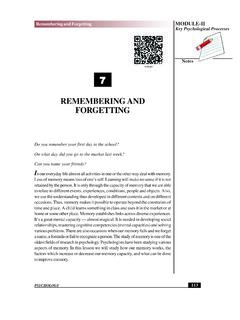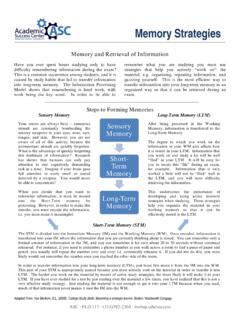Transcription of Remembering the Kanji vol. 1
1 Remembering the Kanjivol. 1A Complete Course on How Not to Forget the Meaning and Writing of Japanese CharactersJames W. Heisigsixth edition University of Hawai i Press honoluluContentsIntroduction .. 1part one: Stories (Lessons 1 12) .. 13part two: Plots (Lessons 13 19) .. 119part three: Elements (Lessons 20 56) .. 187 Indexesi. Kanji .. 431ii. Primitive Elements .. 450iii. Kanji in Stroke Order .. 453iv. Key Words and Primitive Meanings .. 465vIntroductionThe aim of this book is to provide the student of Japanese with a simple method for correlating the writing and the meaning of Japanese characters in such a way as to make them both easy to remember.
2 It is intended not only for the beginner, but also for the more advanced student looking for some relief to the constant frustration of forgetting how to write the Kanji and some way to systematize what he or she already knows. By showing how to break down the complexities of the Japanese writing system into its basic elements and suggesting ways to reconstruct meanings from those elements, the method offers a new perspective from which to learn the are, of course, many things that the pages of this book will not do for you. You will read nothing about how Kanji combine to form compounds.
3 Nor is anything said about the various ways to pronounce the characters. Furthermore, all questions of grammatical usage have been omitted. These are all matters that need specialized treatment in their own right. Meantime, Remembering the meaning and the writing of the Kanji perhaps the single most difficult barrier to learning Japanese can be greatly simplified if the two are isolated and studied apart from everything Kanji , Remembering kanjiWhat makes forgetting the Kanji so natural is their lack of connec-tion with normal patterns of visual memory.
4 We are used to hills and roads, to the faces of people and the skylines of cities, to flowers, animals, and the phe-nomena of nature. And while only a fraction of what we see is readily recalled, we are confident that, given proper attention, anything we choose to remem-ber, we can. That confidence is lacking in the world of the Kanji . The closest approximation to the kind of memory patterns required by the Kanji is to be seen in the various alphabets and number-systems we know. The difference is that while these symbols are very few and often sound-related, the Kanji number in the thousands and have no consistent phonetic value.
5 Nonetheless, traditional methods for learning the characters have been the same as those for learning alphabets: drill the shapes one by one, again and again, year after year. Whatever ascetic value there is in such an exercise, the more efficient way would be to relate the characters to something other than their sounds 12 | introductionin the first place, and so to break ties with the visual memory we rely on for learning our origins of the Japanese writing system can be traced back to ancient China and the eighteenth century before the Christian era.
6 In the form in which we find Chinese writing codified some 1,000 years later, it was made up largely of pictographic, detailed glyphs. These were further transformed and stylized down through the centuries, so that by the time the Japanese were introduced to the Kanji by Buddhist monks from Korea and started experi-menting with ways to adapt the Chinese writing system to their own language (about the fourth to seventh centuries of our era), they were already dealing with far more ideographic and abstract forms. The Japanese made their own contributions and changes in time, as was to be expected.
7 And like every mod-ern Oriental culture that uses the Kanji , they continue to do so, though now more in matters of usage than fascinating is this story that many recommend studying etymology as a way to remember the Kanji . Alas, the student quickly learns the many disad-vantages of such an approach. As charming as it is to see the ancient drawing of a woman etched behind its respective Kanji , or to discover the rudimentary form of a hand or a tree or a house, when the character itself is removed, the clear visual memory of the familiar object is precious little help for recall-ing how to write it.
8 Proper etymological studies are most helpful after one has learned the general-use Kanji . Before that, they only add to one s memory problems. We need a still more radical departure from visual me paint the impasse in another, more graphic, way. Picture yourself holding a kaleidoscope up to the light as still as possible, trying to fix in mem-ory the particular pattern that the play of light and mirrors and colored stones has created. Chances are you have such an untrained memory for such things that it will take some time; but let us suppose that you succeed after ten or fifteen minutes.
9 You close your eyes, trace the pattern in your head, and then check your image against the original pattern until you are sure you have it remembered. Then someone passes by and jars your elbow. The pattern is lost, and in its place a new jumble appears. Immediately your memory begins to scramble. You set the kaleidoscope aside, sit down, and try to draw what you had just memorized, but to no avail. There is simply nothing left in memory to grab hold of. The Kanji are like that. One can sit at one s desk and drill a half dozen characters for an hour or two, only to discover on the morrow that when something similar is seen, the former memory is erased or hopelessly confused by the new the odd thing is not that this occurs, but rather that, instead of openly admitting one s distrust of purely visual memory, one accuses oneself of a introduction | 3poor memory or lack of discipline and keeps on following the same routine.
10 Thus, by placing the blame on a poor visual memory, one overlooks the possi-bility of another form of memory that could handle the task with relative ease: imaginative imaginative memory I mean the faculty to recall images created purely in the mind, with no actual or remembered visual stimuli behind them. When we recall our dreams we are using imaginative memory. The fact that we sometimes conf late what happened in waking life with what occurred merely in a dream is an indication of how powerful those imaginative stimuli can be.









